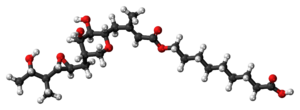June 2023
Ceftolozane-tazobactam
Class: 5th generation cephalosporin.Available as ceftolozane-tazobactam, a beta lactam-beta lactamase inhibitor (BLBLI) combination. Mechanism of Action: Similar to other beta-lactam antibiotics. It binds to the penicillin-binding protein (PBP) to inhibit the biosynthesis of the cell wall.It binds with the PBP3 of E coli and PBP3, PBP1a, and PBP1b of Pseudomonas aeruginosa. Mechanism of resistance: It is […]
Lefamulin
Nature of the antibiotic Semi-synthetic, pleuromutilin class.Molecular weight – 567.79 gm/mole Pleuromutilins Pleuromutilins (produced by Pleurotus sp.), discovered in the 1950s, have a tricyclic mutilin core.Tiamulin – the first member of this group, was approved for veterinary use in 1979.Retapamulin – topical pleuromutilin was approved for human use in 2007. Mechanism of action It inhibits protein […]
Metronidazole
Class: Nitroimidazole.Mol weight: 171First used in 1960. Mechanism of action: Metronidazole enters the susceptible (bacterial/parasite) cells by passive diffusion. It gets activated to a nitroso compound which causes oxidative damage to the DNA. It also inhibits DNA repair. The conversion of metronidazole to nitroso compound creates a concentration gradient, and more metronidazole enters the cells. The aerobic bacteria lack the necessary […]
Mechanism of resistance in Enterococcus
Enterococci are intrinsically resistant to many classes of antibiotics – like cephalosporins, Aminoglycoside (low-level resistance), macrolides, clindamycin, quinupristin-dalfopristin (E faecalis), Fusidic acid, Sulfonamide [EUCAST], which limits our options when we try to treat Enterococcal infections. Most clinical infections are caused by Enterococcus faecalis, followed by Enterococcus faecium.Other Enterococci occasionally isolated from the clinical specimen are […]
Antibiotic – intrinsic resistance
Microorganisms are only listed as “intrinsically resistant” to an agent (or group of agents) when a vast majority of wild-type isolates exhibit MIC values that are so high that the agent should not be considered for either therapy or clinical susceptibility testing (EUCAST). Enterobacterales & Aeromonas Enterobacterales and Aeromonas are intrinsically resistant to benzylpenicillin, glycopeptides, […]
Cefalexin
Nature of the antibiotic Mechanism of action Cefalexin, like other beta-lactams, binds to the penicillin-binding protein (PBP) and prevents peptidoglycan synthesis. It prevents the formation of new cell walls and maintenance of the cell wall leading to autolysis of the bacteria due to osmotic pressure. Mechanism of resistance PK/PD and other properties Indication (cefalexin is […]
Fusidic acid
Fusidic acid was discovered in Copenhagen, Denmark and introduced to clinical practice in the 1960s.It was derived from a fungus, Fusidium coccineum. Fusidic acid has a structural similarity with the steroid molecule. You can see in the picture the molecular structure is similar to prednisolone. For this reason, it is called a steroid antibiotic. It also […]
Antimicrobe.org: Acinetobacter species
This is an effort to preserve some wonderful materials I used as a trainee. This website is not being updated anymore and may disappear in the future. I have no intention of infringing the copyright - if antimicrobe.org wishes me to remove the material, please get in touch with me. Updated June, 2013 Kevin J. […]







